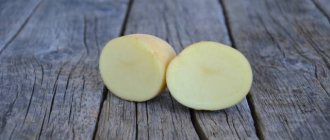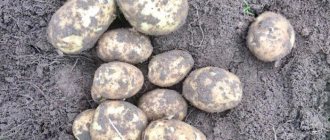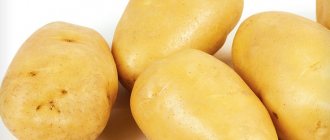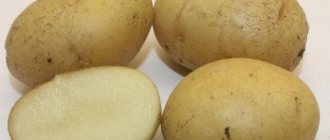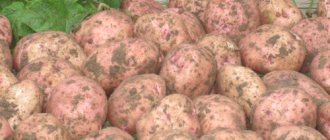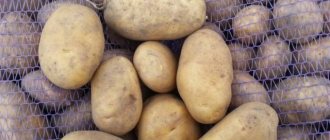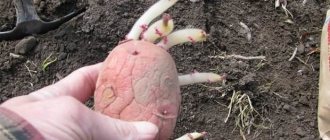In recent years, the Inara variety has occupied a leading position in the line of mid-early potato varieties. This interest is caused by the good yield and relative unpretentiousness of the Inara variety among other mid-early ripening potato varieties.
Taste qualities, agricultural technology and low requirements for storage conditions make it possible to achieve high results in personal subsidiary plots and farms, as well as to grow the Inara variety on an industrial scale in those regions of Russia that are traditionally considered areas of risky farming.
Origin story
The authors of the variety are breeders from Norika Nordring Kartoffelzucht und Vermehrungs GmbH. Norika has fifty years of experience in successfully breeding and growing elite potato varieties. It is noteworthy that the Inara variety was obtained in the climatic conditions of the island of Rügen, located in the Baltic Sea, which in their severity resemble the Central and Middle regions of the Russian Federation.
It is noteworthy that the creators of the Inara variety continue to supervise their product, issuing licenses for the cultivation of seed material to German farmers, as well as monitoring the varietal qualities of Inara from official distributors in the Arkhangelsk region and in other regions of Russia, involved in the popularization of varietal potatoes of the German company.
Potatoes of the Inara variety have passed phytosanitary control on the territory of the Russian Federation and are allowed for distribution and cultivation. Currently, the variety is widespread not only in the recommended areas, but also in the south of Russia.
How to collect and store potatoes
The season ends, and then the folk wisdom comes to mind: “Chickens are counted in the fall.” If you do not harvest the potatoes on time and correctly, you can waste all the efforts and costs of growing the crop.
| Potato variety | Harvesting time after planting (days) |
| Ultra early | 35—50 |
| Early | 55—65 |
| Mid-early | 65—80 |
| Mid-late | 95—110 |
| Late | More than 110-120 |
The first signal that it is time to harvest is yellowed, drying tops. But it happens that the tops are green, but the calendar date has already come. The reason is excessive doses of nitrogen-containing fertilizers. Therefore, the ripeness of tubers can be most accurately determined by periodically selectively digging up the bushes.
If you dig up potatoes with weak skins, then after several transfers: from the ground to a bucket, from a bucket to a bag, then transportation and storage in the cellar, you will get severely damaged tubers. Potatoes cannot be preserved in this form; they must be sold immediately as food.
For potatoes that have lain in the ground for too long, if the harvest date has been missed, there is a high probability that the tubers may rot. Long autumn rains can add a fly in the ointment.
A week and a half before the scheduled harvest date, it is better to cut off the tops at a level of 10-12 cm. The potato skin will become stronger and the starch content in the tubers will increase. Do not use cut tops for compost; it is better to burn them.
Monitor the weather forecast and choose a dry, sunny but hot day for cleaning. Tubers should be dug up with a pitchfork on light soils and a shovel on heavy soils. Correctly assess the distance at which the tubers are located so as not to damage them.
Do not keep the dug up tubers in the sun for more than an hour - as soon as they dry, put them indoors in the shade. Do not immediately put it into the cellar; within a week you will remove the tubers that have begun to rot. And now we can go to the cellar. The best temperature for storage is 5 degrees.
Description and characteristics
The Inara variety is distinguished by medium-sized bushes, up to 80 cm in height. It has erect, succulent stems compactly arranged around a basal rosette. The color of the stems and leaves corresponds to the generic characteristics of potatoes:
- light green - at the beginning of the growing season;
- dark green shade in the flowering phase;
- yellow and brown - in the phase of biological maturity.
The leaves of the plant are paired, oval in shape, slightly pointed at the tips, on short petioles, with a relief pattern.
During the flowering period, potatoes throw out flower stalks in “clusters”. The Inara variety has white flowers with yellow bases on the sepals.
The root system of potatoes is located close to the soil surface and has a fibrous structure. Inara forms 8-10 tubers on stolons, weighing from 80 g to 140 g. The number and weight of tubers depend on agrotechnical and climatic factors.
Inara potatoes are popular due to their universal table qualities, the correct shape of oval tubers, without deep eyes. The peel at the stage of biological maturity has a golden-brown hue, the flesh of the tubers is moderately dense, cream-colored when raw, white after heat treatment.
Description of the potato variety Inara
Potato Inara is a variety of German selection, bred by specialists of the Norica company (Gross Lyuzevtsi, Germany). It passed successful tests in Russia, and in 2013 it was included in the register of breeding achievements. Recommended for cultivation in the middle zone and in the Volga-Vyatka region. It is unpretentious, so it can be bred in other areas, including the Urals and Siberia.
Main characteristics of Inara potatoes:
- table (starch content 12-15.5%);
- early ripe (technical ripeness after 45 days, biological ripeness after 80);
- medium or tall (up to 70-80 cm);
- plant of intermediate type.
Inara potato bushes are semi-erect or erect, quite compact. The leaves are small, green, with pointed tips. Their petioles are small, their surface is textured, and they are located in pairs on the stem. The shoots are strong and thick. Moreover, the color of the branches and foliage changes noticeably over time:
- after emergence – light green;
- during flowering – dark green;
- after the tubers finally ripen - yellowish with brown tints.
The flowers of the Inara potato are white, with yellow stamens. Flowering is lush and abundant. Moreover, already at a temperature of 23-25 degrees the plant sheds its inflorescences. At this point, the tops can be irrigated with water, preferably in the evening. The root system is fibrous and lies close to the surface layer of soil, so it is better to plant tubers deeper (especially if the soil is light and loose).
The tubers of the Inara potato are elongated-oval, the eyes are small. The surface is smooth, yellow. The dimensions are quite large - 3-5 cm in diameter, weight 100-120 g. The pulp is dark yellow when cut, boils soft. The taste according to the registry is good.
Important! The yield of commercial Inara potato tubers ranges from 89% to 96%. The variety can be bred not only for personal consumption, but also for sale.
The length of Inara potato tubers reaches 10-12 cm
Advantages and disadvantages
Inara requires standard conditions of agricultural technology, like any potato variety, and only if all the rules are followed can the advantages of the variety be discovered.
| pros | Minuses |
| Suitable for technical cleaning due to the smooth and even surface of the tubers | |
| Productive variety – 25-42 kg/m2 | |
| Standard agricultural technology | |
| Resistance to scab, stem blight, nematodes, rot, potato blight | |
| Satisfactory table quality, starch content 11-14% | |
| Keeping quality 96% | |
| Does not lose density or taste during storage | During storage, requires regular inspection and removal of sprouts |
In addition to compliance with agricultural technology, it is necessary to take into account regional weather and climatic conditions, and soil composition. The quality of the variety is significantly influenced by the seed material.
Growing and care
When cultivating Inara, you should know the varietal nuances - this potato is drought-resistant and does not need frequent watering. Moisture in the area is retained by mulching (straw, hay, rotted leaves, grass are used as mulch).
The variety is early ripening, planted early, needs timely hilling and loosening.
Loosening and weeding
After 8-10 days from the moment of emergence of seedlings, the beds are loosened to a depth of 3 cm around the plants and between the rows. Frequent loosening is not necessary in sandy loam soils. But clay and loamy soils are treated regularly every 7-10 days. The procedure is carried out after watering and precipitation. They use a hoe, a chopper, a flat cutter, or a Tornado ripper.
Weeds that may contain nests of parasites and spores of pathogenic fungi are removed from the site.
Watering
During frequent rainfall, the vegetable is not watered to avoid waterlogging of the soil. During dry seasons, potatoes need up to 3 waterings. The norm per 1 m2 is from 25 to 40 liters of water. Water by drip method, sprinkling technique. Moistening stages – 10 days after germination, at the beginning and at the height of flowering. When the buds fade, watering is stopped so that the tubers do not become watery.
Hilling and feeding
When the shoots grow to 10 cm, carry out the first feeding and hilling. The following products are suitable for fertilizer:
- ammonium nitrate 30 g per 10 l;
- mullein 200 ml, 1 tbsp. ash per 10 l;
- potassium sulfate 30 g, nitrophoska 30 g, 200 ml mullein per 10 l.
Plant remains are used to prepare herbal teas and bioinfusions - dandelion, burdock, nettle. Do not use fresh manure and droppings, as there is a high risk of burning the plants. The earth is poured to half the height of the bushes. The first hilling will reliably protect against low temperatures, frosts, and increase aeration.
After 3 weeks, fertilizers are applied again - these are Kemira, Bulba, Superphosphate. At the same time, plants are hilled up to 2/3 of the length of the stems. The procedure is performed after precipitation or wetting of the beds. For hilling large areas, special equipment is used - a plow, a disk hiller, a walk-behind tractor.
At the height of flowering, fertilize with superphosphate, potassium sulfate, and potassium chloride. The amount of nitrogen compounds is reduced - nutrition should contribute to the formation and increase in the mass of tubers.
Landing
Planting potatoes begins with preparing the soil immediately after harvesting. The area where potatoes were grown should be given special attention if it is not possible to follow the rules of crop rotation.
- After harvesting potatoes, be sure to clear the area of tops. It is taken outside and burned to avoid soil contamination by infectious agents.
- If the area of the plot is limited, in order to comply with the rules of crop rotation, after harvesting the potatoes, it is advisable to plant spicy leaf crops, radishes or radishes, lettuce, some types of cabbage, and legumes on the plot. Since the harvesting period for Inara potatoes begins in June, you can get a double benefit: improve the soil composition and get an additional harvest of other, early-ripening or frost-resistant crops.
- In the fall, the area planned for growing potatoes is dug up to a depth of 30-40 cm, manure is added (10 kg/m2), since potatoes produce an excellent harvest when grown in soil enriched with organic matter.
- In the spring, when re-digging and loosening the soil for planting potatoes, you should definitely add urea, nitrogen, potassium and phosphorus mineral fertilizers.
Advice!
To destroy weeds and larvae of garden pests remaining on the site after harvesting, 7-10 days before autumn digging, in warm and dry weather, treat the soil with insecticides and herbicides. This measure will increase the future potato harvest by 15-20%.
The Inara variety, like all potato varieties, prefers fertile and light soil, with good aeration and moderate humidity. Therefore, it is important to improve the composition of clay soil by adding sand and dolomite flour. Potatoes are not very sensitive to soil acidity levels, and high humidity can cause many diseases, spoil the varietal qualities of Inara potatoes, and shorten shelf life.
Before planting, it is necessary to place the tubers in a warm room and germinate for 20-30 days. The strongest sprouts are left on the tubers, and the rest are removed. For rapid germination, tubers are treated with biostimulants - this technique allows you to get a healthy harvest with a good increase, and also largely regulates the optimal timing of planting the mid-early variety Inara.
Planting patterns may vary. In private household plots, where planting and harvesting potatoes is carried out manually, two traditional methods are mainly used: trench and square-cluster. 5-6 tubers are planted per square meter of plot, leaving such a distance between future plants so that the grown bushes close together, forming a microclimate in the root zone. But at the same time, you should not thicken the plantings so much that the plants interfere with each other in the development of tubers.
Therefore, the optimal distance between rows of the Inara variety, taking into account the structure of its bushes, is 50 cm. The distance in the row should be the same. It is allowed to shift the planting pattern by 10 cm towards increasing row spacing or in rows. The 50x70 cm pattern is used when growing beans and potatoes at the same time.
Attention! Beans are a natural protector of potatoes from the Colorado potato beetle and a source of nitrogen in the soil.
In addition, beans can protect potatoes from the heat, serving as a backdrop crop.
The depth of planting of tubers depends on the composition of the soil:
- 5 cm – for clay soil;
- 10-12 cm – for loam;
- 14-16 cm – for sandy soil enriched with organic matter and mineral complex.
When planting potatoes, phosphorus and potassium fertilizers are applied to a hole or trench. The timing of planting prepared seed material is determined by regional weather conditions. It must be taken into account that the technical ripeness of Inara potatoes occurs 40-45 days after emergence, and biological maturity occurs after 80 days.
Characteristics of the potato variety Inara
Inara potatoes have good resistance to adverse weather conditions. It tolerates soil frosts and dry periods well. Keeping quality of tubers is up to 96%. The skin is quite durable, so the potatoes do not crack even during long transportation. Application area: universal: for cooking, frying and stewing.
Productivity
Yield indicators according to the register of selection achievements are:
- 0.8-1.2 kg from 1 bush;
- 2.6-4.0 kg per 1 m2;
- 260-400 kg per 1 hundred square meters.
The maximum yield is 469 kg per hundred square meters. You can achieve high results if you grow Inara potatoes in fertile soils with a light structure. It is also necessary to follow the basic rules of care:
- good pre-sowing soil preparation;
- regular loosening;
- weekly watering during drought;
- 2-fold feeding and hilling;
- if possible, mulch the plantings with sawdust or straw.
Inara potatoes ripen in a short time - the first dig can be made 45 days after the first shoots. At this point, the yield will be from 100 to 200 kg per hundred square meters. The deadline for the second digging is in 55 days (140-230 kg per hundred square meters). The last time the tubers are harvested is 80 days after germination, that is, at the end of July or early August.
Advantages and disadvantages
Inara potatoes are valued for their good taste, long shelf life and smooth surface, thanks to which the tubers can be peeled automatically. In addition, this variety has other advantages.
Inara potatoes have an attractive presentation
pros
- good yield;
- pleasant taste;
- high shelf life;
- tubers are transportable;
- attractive presentation;
- the eyes are hardly noticeable, the surface is smooth;
- resistance to late blight;
- undemanding to care - standard agricultural technology.
Minuses
- potatoes are boiled;
- during storage it produces sprouts that need to be removed;
- Moderate immunity to mosaic and leaf curl.
Care
7-10 days after planting potatoes, a period of regular care for the future harvest begins, and continues until the tubers are stored for storage. Standard agrotechnical rules for growing potatoes apply to the cultivation of the Inara variety. Each stage of care plays an important role, so the necessary agrotechnical measures cannot be ignored.
Loosening and weeding
Before emergence, the area is harrowed to remove weeds.
Soil aeration improves the taste of potatoes and increases yield. In heavy soil, regular loosening of row spacing is also necessary because the high density of the soil deforms the tubers, and they take on an unmarketable appearance.
Regular weeding of rows and destruction of weeds on the site is very important. This is a preventative measure in the fight against pests and diseases. The manufacturer states that Inara is a resistant variety, but its strength should not be tested.
Loosening is carried out after rain or watering, to remove crust on the surface, as well as to destroy weeds.
Watering
Artificial watering of potatoes is necessary during dry periods and in cases where sand predominates in the soil. Inara potatoes tolerate drought relatively easily, but lack of moisture affects the formation and growth of tubers. At the same time, excess moisture is also not welcome when growing potatoes.
At prolonged temperatures above 220C, buds begin to drop and tuber growth stops. At this time, it is advisable to support the bushes with irrigation, which is best done in the evening.
Hilling and feeding
In the phase when the seedlings reach a height of 15 cm, the first hilling is required, which protects the root system from moisture evaporation and activates the formation of tubers. The first hilling may be preceded by additional feeding with potassium and phosphorus, or complex preparations with the addition of microelements. Before fertilizing, plants need to be watered thoroughly. At the beginning of budding, a second hilling is carried out, which promotes additional tuber formation.
Features of cultivation
Caring for Inara potatoes is simple and includes several steps:
- Watering during the first month and during the heat - weekly in a bucket for 2-3 bushes (it is better to pour it into the rows).
- Hilling 2 times per season: after the tops reach a height of 15 cm and during budding.
- On the eve of hilling, Inara potatoes can be fed with azofoska or a mixture of potassium salt and superphosphates. It is also permissible to use organic matter instead.
- Loosening - 2-3 times a month, especially after watering or rain.
- Weeding - regularly.
You can feed Inara potatoes when the first shoots appear and before flowering begins.
Diseases and pests
When growing potatoes of any variety, it is impossible to do without preventive measures to combat pests. If gardeners do not have sufficient knowledge in the field of agrochemistry, then it is better to stock up on universal-spectrum insecticides that have been on the market for a long time and have been successfully used: Taboo, Barrier - universal preparations of the new generation. An old, proven and effective remedy is Bordeaux mixture, which is also suitable in the fight against infections.
Folk remedies have also proven themselves to be excellent in the fight against pests and diseases: infusions of chamomile, celandine, mustard or walnut leaves. These products are used to irrigate bushes. Cut grass and leaves are scattered between the rows.
Attention! The cause of diseases in potatoes and all vegetable crops is often a violation of agricultural practices, leading to weakening of plants.
Planting and growing Inara potato varieties
In order for the plant to bear a good harvest, it is necessary to remember the rules and timing of planting.
Planting potatoes on the site
Preparing for landing
One of the main conditions for planting is compliance with the rules of crop rotation. It is not recommended to select potatoes from the first year of planting for propagation. To assimilate tubers in the ground, care must be taken to ensure that the site is properly selected and the soil is prepared.
Planting is carried out in those places. where other plant crops have been growing over the past few years. For example, tomatoes, cabbage or eggplants. When preparing the soil, it is worth treating it with herbicides, which help remove weeds and larvae of pathogenic organisms. The procedure is carried out 2-3 weeks before planting the tubers.
Harvesting
If the Inara variety is intended for summer consumption, then it is permissible to begin harvesting at the stage of technical maturity - 45-50 days. At this time, the bushes are in the active flowering phase, and in the underground part of the plants there are already formed tubers. The stems and leaves of the plants retain their green color and juiciness. Green tops are mowed two days before harvesting potatoes.
“New” potatoes are stored for no more than two weeks at a temperature of 2-50C, in paper bags or canvas bags, which prevent the formation of condensation. Therefore, when harvesting potatoes at the stage of technical ripeness for personal consumption, it is better to dig up the tubers as they are consumed in order to ensure better preservation of the product.
Potatoes for winter consumption and for planting are harvested at the stage of biological maturity. For the Inara variety, this period begins after 80 days. But depending on regional climatic conditions, these dates may shift in one direction or another. The degree of potato maturity can be determined by the main external sign of the plants: the end of the potato growing season is characterized by wilting and massive lodging of the stems. Next, within 3-4 weeks, the biological maturation of the tubers occurs. Potatoes are ready for harvesting when their skins are thick.
It is better to carry out harvesting in dry weather, but if this is not possible, then the dug up potatoes are dried under a canopy, protected from sunlight, the soil is removed, and sorted. Selected seed material is processed separately and stored. Tubers affected by insects and diseases are discarded.
The storage room is disinfected with slaked lime, copper sulfate, and ventilated. During the entire storage period, the temperature in the basement should be maintained at 3-50C.
Harvesting and storage
You can start harvesting already 1.5 months after the first shoots appear, that is, in early July. At this point, the tubers are still small, although they are quite edible. Final harvesting is carried out 3 months after planting - in the first half of August. To do this, choose dry and warm weather. The collected tubers are laid out on the ground to dry, then sorted and packed into bags.
Small and very large root vegetables are consumed first. The rest are sent for storage in a dark room with a temperature of 12-14 degrees (the first 2 weeks) and 2-4 degrees (until the next winter). The humidity level is constant – 70-80%.
Freshly dug Inara potato tubers should lie in the sun for a while
Pests and diseases
Inara potatoes are one of the few varieties that have good immunity to late blight. The variety is also moderately resistant to leaf curl and wrinkled mosaic. At the same time, we cannot exclude the risk of other diseases - rot, scab - as well as insect infestations:
- aphid;
- Colorado potato beetles;
- mole crickets;
- wireworms;
- potato moth;
- May beetle larvae.
Since preventing the occurrence of diseases and pests is always easier than dealing with the consequences, summer residents and farmers recommend adhering to standard prevention rules:
- Do not plant Inara potatoes in the same field for more than 3 years in a row.
- Plant fragrant tobacco, calendula, marigolds, and coriander near the site.
- Do not plant tubers where tomatoes or potatoes have been growing for a long time (the best predecessors are winter crops and legumes).
- Be sure to treat the tubers before planting.
- Spray the grown tops (15-20 cm) with fungicide.
- Treat with insecticides if insects are found.
To prevent fungal diseases of Inara potatoes, various drugs are used:
- Bordeaux mixture;
- "Prestige";
- "Quadris";
- "Maksim";
- "Fitosporin".
To cope with insects, bushes can be treated 1 or 2 times with insecticides:
- "Medvetox";
- "Green Soap";
- "Fitoverm";
- "Agravertine";
- "Decis".
It is not necessary to use chemicals right away - folk remedies are also suitable for prevention. For example, you can pour sawdust into the spaces between the rows or pour a weak tar solution there 2-3 times a season. Inara potato bushes should be periodically dusted with wood ash (in dry and windless weather), and if pests appear, sprayed with an infusion of mustard powder, chili peppers, and garlic.
Attention! It is better to immediately remove and burn bushes that are heavily affected by diseases so that they do not infect neighboring plants.
Growing
Plants need to be looked after
The main rule for growing this type of potato is to observe crop rotation. You should not take seed potatoes from the first year of planting for propagation. The variety is not prone to degeneration. To get a good harvest, you should perform a number of agrotechnical measures:
- choose the right site;
- prepare the soil;
- select planting material;
- provide good care after planting.
Inara potatoes are a heat-loving plant, so it is better to choose well-lit areas. It is not recommended to plant potatoes on slopes. The best yields are observed on fertile soils and sandy loam soils.
It is recommended to plant from north to south. This way, each plant will receive enough light, and the bush will develop evenly. The larger the potatoes selected for seeds, the wider the step should be taken between the holes.
Preparing the garden
When planting varietal potato varieties, it is imperative to follow the rules of crop rotation. You cannot plant potatoes in the same place, or after tomatoes, eggplants and cabbage. During the autumn cultivation of the site, it is recommended to apply herbicides. These drugs help disinfect the soil, effectively remove the roots of weeds and destroy the larvae of all kinds of parasites. If possible, add sand to soils that are too hard.
The soil is cultivated to a depth of about 30-40 cm. Fertilizers are applied. At this stage, you can use unrotted compost or fresh manure.
Seed preparation
Potatoes from the first year of planting should not be used for seeds. It is better to harvest for 2-3 years. When harvesting root crops, the largest even tubers without visible damage are immediately selected. The optimal size of seed potatoes is 5-10 cm.
For better preservation, the seed needs to be greened. To do this, it is kept in a warm, lighted room for a week. Then they are lowered into the vegetable storehouse. Seed material should be stored separately. To protect against rodents and improve shelf life, they are also sprayed with a 2% solution of copper sulfate.
In the spring, seed material is taken out of the cellar, sorted and germinated in any convenient way. Germination will take about 3 weeks. If you plan to propagate potatoes by seedlings, the sprouts are removed.
Landing
The standard time for planting Inara potatoes is late March-early April in the southern regions. In the central regions, the deadlines are shifted by 2 weeks. In the northern regions, it is advisable to grow potatoes in greenhouses or greenhouses. The planting depth depends on the quality of the soil. On light sandy, fertile soils, potatoes should be buried 12 cm.
On heavy soils, the planting depth should be 5 cm, no more. Planting can be done using several methods:
- under the shovel;
- in trenches;
- seedlings.
The smooth planting method is considered universal and is used everywhere. The trench method and propagation by seedlings help improve the quality and increase the quantity of the harvest. When propagating by seedlings, after germination, the sprouts should be removed from the tubers and planted in a large container. The soil mixture for seedlings is prepared from peat, sand and garden soil. The sprouts need to be immersed halfway in the soil, watered and covered with polyethylene.
The most common planting method is under a shovel.
When the shoots appear, the covering material is removed and the shoots are planted in different containers. Before planting in open ground, seedlings need to be hardened off. To do this, place it in a more illuminated room and gradually reduce the air temperature. When planting in open ground, the conditions for all methods will be the same.
Organic fertilizers should be added to each hole. Inara potatoes are planted in increments of 60 cm and a distance between rows of 70-80 cm. When planting under a shovel and in trenches, additional watering is not required. When planting seedlings, you need to slightly moisten the soil, but do not turn it into a swamp.
Potato planting methods
You can proceed directly to planting by choosing seed potatoes. Varieties are different and require an individual approach. Let's look at several ways to plant potatoes:
- Method 1
. The traditional method is square-nested. To do this, divide a plot of land into squares measuring 50 x 50 cm and make rows in which seed potatoes are planted. - Method 2
. A type of strip planting, only this happens in 2 rows at a distance of 30 and 100 cm. The tubers are not buried, but sprinkled on top with a layer of soil of no more than 3 cm. The wide distance helps to properly care for the potatoes. This method increases harvest efficiency by an average of 30%. - Method 3
. Trench method. Dig trenches 20-25 cm deep and 35 cm wide. Plant residues and weeds are placed at the bottom, and covered with a layer of humus, ash and fertilizer on top. Sprouted seed potato tubers are placed on top and sprinkled with soil. The distance between the trenches is about 70 cm. - Method 4
. Growing in separate flowerbeds. According to this method, each potato tuber is planted in a separate flower bed made of tires or barrels. All the necessary nutrients are poured inside and potatoes are planted. - Method 5
. Planting under straw. This method can be used to plant any seed potatoes. Any variety is suitable for this method. Straw helps retain moisture and prevents weeds from growing. Potatoes do not need hilling.
Seed potatoes: how to choose
Since potatoes are propagated mainly by tubers, the main share of success depends on the quality of planting material.
Why shouldn't you use your own potato planting material?
Potatoes, like no other crop, are easily affected by diseases: viral, bacterial, fungal and other infections penetrate through the leaves and accumulate in the tubers. In addition, varieties tend to degenerate. Therefore, you should not constantly use your own planting material - this will affect the harvest. Once every 3-4 years it needs to be updated by purchasing elite planting material grown in a specialized farm. The process of obtaining the “elite” is long and expensive; it begins with growing healthy plants in vitro and takes five years.
Planting tubers
First, we prepare the area where we will grow the crop. Zekura is demanding on soils. The soil must be fertilized, loosened and free of weeds. Also, close proximity to groundwater is not allowed.
The best way to get a good harvest is to alternate potatoes with other vegetables. In particular, potatoes grow well in areas where cucumbers, corn or legumes were grown last season.
If the soil is acidic, then it is necessary to extinguish it. This is done using dolomite flour.
In the fall, apply fertilizer. Phosphorus-potassium ones are ideal. Potatoes do not like nitrogenous fertilizers, as they stimulate the growth of tops too much, inhibiting the development of the root crop itself.
Planting is carried out in early or mid-May. If these are cold regions, then perhaps in April. Reference ambient temperature. It should be at least +9 degrees Celsius.
Zekura potatoes are planted according to the standard scheme. A distance of 25-30 cm is made between the holes, and 70 cm between the rows. Naturally, healthy potatoes with sprouts are selected for planting. Before planting, the tubers are first treated with special chemicals against various diseases.
